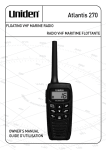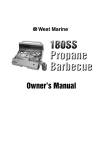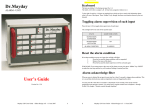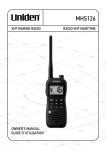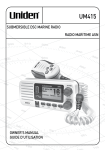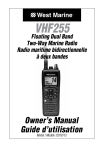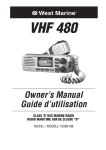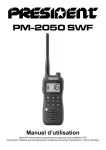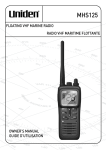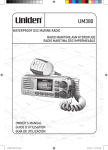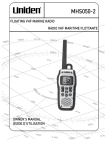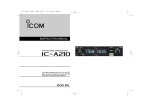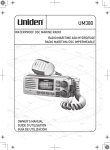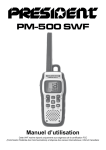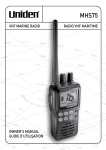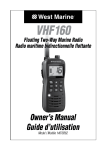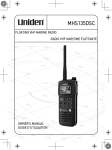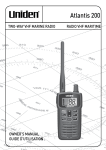Download VHF75 Owner`s Manual Guide d`utilisation
Transcript
VHF75
Owner’s Manual
Guide d’utilisation
FLOATING TWO-WAY MARINE RADIO
RADIO MARITIME BIDIRECTIONNELLE FLOTTANTE
MODEL / MODÈLE : 15155781
Making a Distress Call
For future reference, write your boat’s name & call sign here:
Speak slowly - clearly - calmly.
1. Make sure your radio is on.
2. Press the 16/9-TRI key to switch to Channel 16 (156.8
MHz). (If the corner of the display does not show 16, press
the 16/9-TRI key again until it does.)
3. Press the Push to Talk key and say: “MAYDAY -- MAYDAY
-- MAYDAY.”
4. Say “THIS IS {name of your boat (three times) and call sign/
boat registration number (once)}.”
5. Repeat “MAYDAY {name of your boat}” once.
6. Tell where you are: (what navigational aids or landmarks are
near, or read the latitude and longitude from your GPS).
7. State the nature of your distress (e.g. sinking, medical
emergency, man overboard, on fire, adrift, etc.).
8. State the type of assistance you need (medical, towing,
pumps, etc.).
9. Give the number of persons aboard and describe the
condition of any injured persons.
10.Estimate present seaworthiness of your ship (e.g. how
immediate is the danger due to flooding or fire).
11.Briefly describe your ship, giving ship name (i.e., “Blue Duck
is 32 foot cabin cruiser, white hull, blue deck house”).
12.Say: “I WILL BE LISTENING ON CHANNEL 16.”
13.End the message by saying “THIS IS {name or call sign of
your boat}, OVER.”
14.Release the Push to Talk key and listen.
If you do not get an answer after 30 seconds, repeat your call
beginning at step 3 above.
Faire un appel de détresse
Pour toute référence ultérieure, transcrivez ci-dessous le nom
et l’indicatif d’appel de votre bateau :
Parlez lentement – clairement – calmement.
1. Vérifiez si votre radio est en marche.
2. Appuyez sur la touche 16/9-TRI afin de commuter au canal 16 (156,8
MHz). (Si le canal 16 n’apparaît pas à l’affichage, appuyez de nouveau sur
la touche 16/9-TRI jusqu’à ce qu’il soit affiché.)
3. Appuyez sur le bouton de microphone Push to Talk et dites:“MAYDAY
-- MAYDAY -- MAYDAY”.
4. Donnez l’identité de votre navire en disant : “ICI {nom de votre bateau
(trois fois) ou indicatif d’appel et le numéro d’identification de votre bateau
(une fois)}”.
5. Dites “MAYDAY {nom ou indicatif d’appel de votre bateau} une fois”.
6. Donnez votre position : (quels sont les points de repère ou aides à la
navigation près de vous ou lisez les coordonnées de longitude et de
latitude apparaissant sur votre dispositif GPS).
7. Révélez la nature de votre détresse (par exemple, nous sommes en
train de couler, urgence médicale, un homme à la mer, un incendie, nous
sommes à la dérive, etc.
8. Révélez la nature de l’aide désirée (médicale, remorquage, essence, etc.)
9. Donnez le nombre de personnes à bord et les conditions des blessés, s’il
y en a.
10. Donnez la condition de navigabilité actuelle de votre navire, tel que le
degré de l’urgence par rapport une inondation, et une incendie.
11. Donnez une brève description de votre navire en donnant le nom du
bateau (par exemple, “Blue Duck est un yacht de croisière de 32 pieds,
avec une coque blanche et un rouffle bleu.).
12. Dites : “JE VAIS ÉCOUTER SUR LE CANAL 16”.
13. Terminez le message en disant “ICI {nom ou indicatif d’appel de votre
bateau}, À VOUS”.
14. Relâchez le bouton Push to Talk du microphone et écoutez.
Si vous n’obtenez pas de réponse après 30 secondes, répétez
l’appel encommençant à l’étape 3 ci-dessus.
Cómo hacer una llamada de apuro
Para acordarse en el futuro, escriba el nombre y la señal de su
nave aquí:
Hable despacio -- claro -- y con calma.
1. Asegúrese de que la radio está encendida.
2. En la radio, oprima el botón 16/9-TRI para cambiar al canal 16
(156.8 MHz). (Si la esquina de la pantalla no muestra 16, oprima
el botón 16/9-TRI otra vez hasta que lo haga.)
3. Oprima el botón PUSH-TO-TALK (Oprima para hablar) en el
micrófono y diga: “MAYDAY --- MAYDAY--- MAYDAY.”
4. Diga “ESTE ES {nombre de su nave (tres veces) y la señal/
número de registración de la nave (una vez)}.”
5. Diga “MAYDAY {nombre o señal de su nave}” una vez.
6. Describa donde se encuentra: (ayudas de navegación o marcas
destacadas cercanas, o lea la latitud y la longitud en su GPS).
7. Describa la clase de su apuro, ej., se está hundiendo,
emergencia médica, hombre al agua, hay fuego, está a la
deriva, etc.
8. Decriba el tipo de asistencia que necesita (atención médica,
remolque, bombas, etc.).
9. Describa la cantidad de personas abordo y las condiciones de
cualquier persona lesionada.
10. Estime la navegabilidad actual de su nave, ej., cuanto de
inmediato es el peligro de inundación o de incendio o proximidad
a la costa.
11. Describa brevemente su nave (ej., “Blue Duck es un yate de 32
pies, casco blanco, cabina azul”).
12. Diga: “ESTARÉ ESCUCHANDO EN EL CANAL 16.”
13. Termine el mensaje diciendo: “ESTE ES {nombre o señal de su
nave}, OVER.”
14. Suelte el botón PUSH-TO-TALK y escuche.
Si no recibe una contestacion dentro de 30 segundos, repita su llamada,
comenzando con el paso 3, descrito arriba.
Table of Contents
Introduction............................. E-1
Features................................... E-1
Waterproof Specifications..... E-1
Getting Started........................ E-2
What’s included........................ E-2
Parts of the VHF75:.................. E-3
Front view................................E-3
Back view................................E-3
Charger...................................E-4
Reading the display.................. E-5
Display icons and .
what they mean...................E-5
How the Radio Works............. E-6
Normal mode operation............ E-7
Normal mode with .
Weather Alert Watch...........E-7
Normal mode with Triple .
Watch or Dual Watch..........E-7
Scan mode operation............... E-8
Using the radio in scan mode .E-9
Scan mode with Weather Alert
Watch..................................E-9
Scan mode with Triple .
Watch or Dual Watch..........E-9
Weather mode........................ E-10
Using the radio in weather mode.
E-10.
Weather mode with .
Weather Alert Watch.........E-10
Weather mode with Triple .
Watch or Dual Watch........E-11
Setting Up the Hardware...... E-11
Install the Battery Pack........... E-11
Mounting the Charger............. E-12
Charging the Battery............... E-12
Important notes on .
charging the battery..........E-12
Installing and Removing .
the Belt Clip......................... E-13
Using Your Radio.................. E-13
Changing the Volume ............ E-13
Setting the Squelch Level....... E-13
Changing the Channel............ E-14
Making a Transmission........... E-14
Boosting the transmission .
power................................E-14
Setting Key Lock..................... E-15
Setting the UIC Channel Mode.E-15
Turning the Key Beep.
On and Off........................... E-15
Saving a Channel to Memory .E-16
Scanning Channels in Memory.E-16
Battery Save Feature.............. E-16
Maintenance and
Troubleshooting................. E-16
Common Questions................ E-16
Specifications....................... E-18
Channels and .
Frequencies (MHz).............. E-19
US channel frequencies .
and names........................... E-19
Canadian channel .
frequencies and names.....E-21
International channel.
frequencies and names.....E-23
Weather channel .
frequencies and names.....E-25
Regulations and Safety .
Warnings............................ E-26
Maritime Radio Services .
Operation............................. E-26
Basic Radio Guidelines.......... E-26
Introduction
Features
xx Memory scan mode
Lets you save channels to memory and monitor them in
quick succession.
xx Transmitter power level select
Lets you boost the transmitter power from L (Low = 1
Watt) to M (Medium = 2.5 Watts) or H (High = 6) Watts
for added transmission distance.
xx Battery level display.
xx Battery Save
Unit turns off RX power after 3 seconds without RX or
TX.
xx Dual and Triple operation
These different watch modes let you monitor up to two
Coast Guard Distress/Hailing channels along with one
regular marine channel.
xx All marine VHF channels for the U.S., Canada, and
international waters
xx National Oceanic and Atmospheric Administration
(NOAA) Weather Channel watch
Sounds a warning tone when a hazard alert is issued.
xx Keylock On/Off
Locks the keys to prevent accidental input.
xx 9 built-in weather channels.
Waterproof Specifications
The VHF75 is a submersible radio, complying with floating
JIS7/IPX7 water-resistant standards. The radio can be
submerged in 1.0 meters of water for 30 minutes without
damage.
CAUTION! The radio will only meet this rating if fully
assembled and all rubber seals are well maintained and
West Marine VHF75 Radio Owner’s Manual
E-1
correctly fitted. This means that the battery and casing must
be securely fastened.
After your radio is submerged in water, you might notice that
the sound is distorted. This is because there is still water
remaining in and around the speaker and microphone. Just
shake the radio to clear excess water, and the sound should
return to normal.
If your radio is exposured to salt water, clean it thoroughly
with fresh water and dry it before turning it on.
The charger is not waterproof.
Getting Started
What’s included
CHARGE
Charger
VHF75 Radio
Lithium Ion
Battery
Belt Clip
DC Adapter
AC Adapter
Charger
Mounting Hardware
If any pieces are missing or damaged, contact West Marine
Customer Service (see back cover for contact information).
For information on available accessories, visit
www.westmarine.com.
E-2
West Marine VHF75 Radio Owner’s Manual
Parts of the VHF75:
Front view
Antenna
LCD display
Channel up/down
keys
Push to Talk key
6W-Boost key
Lock-UIC key
Scan-Dual
(scan-dual watch)
key
16/9-Tri
(16/9- triple
watch) key
L/M/H-Mem
(memory) key
Power key
WX-Alert
(weather-alert)
key
Microphone
Volume-Squelch
key
Speaker
Back view
Battery cover screw
(under belt clip)
Battery charging
contacts - 3
(one on bottom)
Belt clip
West Marine VHF75 Radio Owner’s Manual
E-3
Key
Press to...
Press and hold to...
Channel
Move up or down one channel Move quickly up or down
Up/Channel
at a time.
the channels.
Down
Push to talk NA
Transmit on a channel
Boost transmission power
6W/BOOST NA
to 6W.
1st press: Go to channel 16.
2nd press: Go to channel 9. Turn Triple Watch on and
16/9-Tri
3rd press: Go back to the
off.
starting channel.
Save a channel into
Change the transmit power
L/M/H-MEM
memory or delete a channel
(see page E-14).
from memory.
Listen to the weather
Turn Weather Alert Watch
WX ALERT
channels.
on and off.
Enter Squelch Setting
Enter Volume Setting mode.
mode. Use Channel
Use Channel Up and
Up and Channel Down
VolumeChannel Down to raise and
to raise and lower the
Squelch
lower the volume (Levels =
squelch settings (Levels
0 - 15).
= 0 - 3).
Power
NA
Turn the radio on and off.
SCAN
Start scanning the channels Turn Dual Watch on and
DUAL
saved in memory.
off.
Switch between US,
Lock the keys; press again to
Lock-UIC
Canadian, or international
unlock.
channels.
Charger
Charging
contacts
CHARGE
CHARGE LED
E-4
Screw holes
for mounting
West Marine VHF75 Radio Owner’s Manual
Reading the display
The LCD display
shows different
information
depending on what
you are doing. This
sample screen
shows some of this
information. The
table below shows
all the possible
icons and what they
mean.
UIC channel mode
(USA, CANada, or
INTernational)
Transmit
power level
(1, 2.5, or 6
Watts)
VOL and SQL display when
the Volume or Squelch
modes are active
The radio is
transmitting
Current channel
number
Triple or Dual
Watch is on
Key Lock is
active
This channel is
saved in memory
Battery
status icon
WX Alert is WX Mode is
enabled
active
Display icons and what they mean
Icon
,
, or
What it means
The transmitter power is set to 6 Watts, MID (2.5
Watts), or 1 Watt.
You are currently transmitting.
,
, or
or
The radio is set to use CANadian channels, US
channels, or INTernational channels.
TRIple Watch or DUAL Watch is turned on.
The keys are locked (Key Lock function is on).
The radio is in Weather mode.
The current channel is saved in memory.
The radio is in Scan mode.
Weather Alert Watch is turned on.
The battery is fully charged, mostly charged, half
charged, mostly empty, or completely empty.
Displays when Volume mode is turned on.
Displays when Squelch mode is turned on.
West Marine VHF75 Radio Owner’s Manual
E-5
How the Radio Works
Your radio has three main operation modes: normal, scan,
and weather.
Mode
What it does
Use it when you
want to...
Monitors a single marine
Monitor a channel or
Normal channel and lets you talk
talk to another radio.
on that channel.
Check a small group
Monitors all the channels
Scan
of regularly-used
you save into memory.
channels for traffic.
Monitors the selected
Hear the current or
Weather
NOAA weather channel. forecasted weather.
To turn it on/
off
(default mode)
Press SCAN/
DUAL
Press WX
ALERT.
In addition to the three operation modes, your radio provides
four different watch modes which you can activate during any
operation mode. In the watch modes, the radio briefly checks
for activity on a specific channel, then returns to its previous
operation.
Watch mode
What it does
Checks the last-used weather
Weather Alert
channel for hazard alerts
Watch
every 7 seconds.
Checks channel 16 for activity
Dual Watch
every 2 seconds.
Checks channels 9 and 16 for
Triple Watch
activity every 2 seconds.
To turn it on/off
Press and hold WX
ALERT for 2 seconds.
Press and hold SCAN/
DUAL for 2 seconds.
Press and hold 16/9-Tri
for 2 seconds.
## Note: Private boats must monitor channel 16 whenever they
are underway. Water-going vessels should have either Triple
Watch or Dual Watch on at all times.
E-6
West Marine VHF75 Radio Owner’s Manual
Normal mode operation
xx To transmit, remove the radio from the charger, then
press and hold the Push to Talk key. Release the key
when you are finished talking.
xx For the best sound quality, hold the microphone about
two inches from your mouth while you’re talking.
xx Press the Channel Up key to move up one channel at
a time. Press and hold the key to scroll quickly up the
channels.
xx Press the Channel Down key to move down one channel
at a time. Press and hold the key to scroll quickly down
the channels.
xx To change the transmit power, press the L/M/H MEM key.
The transmit power switches to the next transmit power
each time you press this key.
Normal mode with Weather Alert Watch
If you activate Weather Alert Watch while operating in normal
mode, the radio
Monitoring Channel 25
checks the most
recently used
Every seven seconds, the
weather channel
radio checks the last-used
every seven seconds.
weather channel.
If it detects a weather
or other hazard alert,
WX Alert wx
it will switch to that
Watch on
weather channel. (If
you are actively transmitting, the radio waits until you finish
your transmission before checking the weather channel.)
Normal mode with Triple Watch or Dual Watch
If you activate Triple Watch while operating in normal mode,
the radio checks channels 9 and 16 every two seconds; with
Dual Watch turned on, the radio only checks channel 16. The
radio will not check channels 9 and 16 while you are actively
transmitting; it waits until your transmission is finished and
then checks the channels.
West Marine VHF75 Radio Owner’s Manual
E-7
Monitoring Channel 25
09 16
09 16
09 16
Every two seconds, the radio
checks channels 9 & 16.
Triple Watch on
Scan mode operation
You can save channels into memory and then use scan
mode to monitor those channels from lowest to highest. If the
radio detects a signal on a channel, it stays on that channel
as long as the signal is received; when the signal stops, the
radio continues scanning.
When it detects a signal, the radio stays
on the channel until you press the
Channel Up button or the signal stops.
08
10
11
12
13
Resume
scan
14
15
The radio scans about
5 channels in 0.5 seconds.
E-8
West Marine VHF75 Radio Owner’s Manual
17
Using the radio in scan mode
xx To activate scan mode, press SCAN DUAL.
xx You must have at least two channels in memory to start
a scan.
xx You cannot transmit while in scan mode. If you press
PTT, you will stop scanning but you will not be able to
transmit on that channel. Press SCAN DUAL to halt
scanning, then find the channel you want to transmit on.
xx To save a channel into memory, select the channel,
then press and hold the L/M/H MEM key. The MEM icon
displays whenever you tune to that channel.
xx To remove a channel from memory, set the radio to that
channel, then press and hold the L/M/H MEM key. The
MEM icon no longer displays.
xx When the radio stays on a channel, press Channel Up to
leave that channel and resume scanning.
xx To end the scan, press the SCAN DUAL key again; the
radio remains on the last scanned channel.
Scan mode with Weather Alert Watch
If you activate Weather Alert Watch while in scan mode, the
radio checks the most recently-used weather channel every
seven seconds, then continues scanning the next channel in
memory:
Memory Channel Scan
08
10
11
12
13
Every seven seconds, the
radio checks the last-used
weather channel, then scans
the next channel.
14
15
17
20
24
WX Alert
Watch on
25
wx
Scan mode with Triple Watch or Dual Watch
If you activate Triple Watch while operating in scan mode,
the radio checks channels 9 and 16 every two seconds, then
West Marine VHF75 Radio Owner’s Manual
E-9
goes on to scan the next channel; with Dual Watch turned
on, the radio only checks channel 16:
Memory Channel Scan
08
10
11
Every two seconds, the
radio checks channels 9
& 16, then scans the
next channel.
12
13
09 16
14
15
17
20
24
25
Triple
Watch on
Weather mode
The NOAA weather channels now cooperate with the FCC to
alert you of other hazards besides weather (child abduction
alerts, nuclear, biological, etc.). In weather mode, the radio
monitors one of the nine NOAA weather channels. If any type
of alert is received, the radio sounds an alert tone and the
display blinks.
Using the radio in weather mode
xx
xx
xx
xx
You cannot transmit while in weather mode.
To enter weather mode, press the WX ALERT key.
To turn off the radio’s alert tone, press any key.
To cancel weather mode and return to the previous
marine channel, press the WX ALERT key again.
Weather mode with Weather Alert Watch
Because weather mode already monitors the weather
channels, you don’t need Weather Alert Watch to check
the weather channel every seven seconds. If you activate
Weather Alert Watch while operating in weather mode,
it operates as a type of “sleep mode”: the radio stays on
the weather channel and mutes the speaker. If an alert
is detected, the radio sounds an alert tone and turns the
speaker back on. This mode is very useful when you are
anchoring for the night but want to keep informed of hazards.
E-10
West Marine VHF75 Radio Owner’s Manual
Weather mode with Triple Watch or Dual Watch
If you activate Triple
Watch while operating
in weather mode, the
radio checks channels
9 and 16 every two
seconds; with Dual
Watch turned on, the
radio only checks
channel 16.
Monitoring Weather Channel WX08
09 16
09 16
Every two seconds, the radio checks
channel 9, then c.hannel 16.
09 16
with Triple Watch on
Setting Up the Hardware
Install the Battery Pack
Your radio uses the supplied Lithium Ion battery pack. To
install the Lithium Ion battery pack:
1. Remove the belt clip if installed.
2. Use a screwdriver to turn the battery compartment screw
counterclockwise and then lift up and remove the battery
cover.
3. Line up the battery’s connector with the jack inside the
battery compartment (the connector only fits one way).
4. Push the connector in firmly. Tug on the battery wires
gently to make sure you have a good connection.
5. Before replacing the battery cover, check the rubber seal
located on the under side of the cover; make sure that
the seal is set in the groove and that there is no foreign
matter under the seal.
## Note: If the rubber seal appears warn, nicked, or dried out,
you must replace it. New seals are available through the Parts
Department (see the cover page for contact information).
6. Replace the battery compartment cover. Tighten the
screw securely.
West Marine VHF75 Radio Owner’s Manual
E-11
Mounting the Charger
You can mount the charger on any flat, dry area.
1. Use the two holes at the base of the charger
as a template to mark the drill holes.
2. Using a 1/8-inch (or 3 mm) drill bit,
drill two holes 1/2 inch (13mm) deep.
3. Use the provided screws to attach the
charger to the surface.
Charging the Battery
Your radio includes a charger and a
rechargeable battery pack. Place your radio
in the charger with the display facing forward.
Make sure that the CHARGE LED on the
charger turns orange.
Cautions:
xx Use only the battery and charger supplied with
this radio. Using a different charger or battery can
damage the radio and create a risk of fire or shock.
xx The charger is not waterproof. If the charger falls into
the water, unplug it before attempting to remove it
from the water. After you remove the charger from the
water, please contact Customer Service (see the back
cover page for contact information).
xx Dry and clean your radio before placing in the
charger.
Important notes on charging the battery
xx Charge the battery fully before using the radio. When the
battery is completely charged, the CHARGE LED turns
green.
xx Don’t use the charger when the ambient temperature is
below 41° F (5° C) or above 104° F (40° C).
E-12
West Marine VHF75 Radio Owner’s Manual
xx If the radio is powered down, the battery can charge
in about seven hours. (If the radio is powered on, the
battery takes longer to charge.)
Installing and Removing the Belt Clip
To install the belt clip:
Slide the belt clip down over the latch until you hear it click.
To remove the belt clip:
1. Lift the flat latch.
2. Slide the clip up until it comes free of the latch.
Using Your Radio
Changing the Volume
To increase the speaker volume, press the VOL SQL key.
The screen displays VOL and a volume level number. Use
the Channel Up and Channel Down keys to raise or lower
the volume. Press the VOL SQL key again to set the volume
level and return to the main display. There are 16 volume
levels - 0 (mute) to 15.
Setting the Squelch Level
The squelch feature
reduces static on the
Strong signals
speaker by filtering
out any background
Weak signals
channel noise. At the
lowest squelch level,
Noise
the speaker plays all
signals, including any
channel noise.
Medium
No
Setting the squelch
Squelch
Squelch
level higher filters out
noise and lets only
actual radio transmissions through.
High
Squelch
West Marine VHF75 Radio Owner’s Manual
E-13
To adjust the squelch level, press and hold the VOL SQL
key. The screen displays SQL and a SQUELCH level number
(0 - 3). Use the Channel Up and Channel Down keys to
adjust the squelch level. Press and hold the VOL SQL key
again to set the squelch level and return to the main display.
## Note: Setting the squelch level too high may prevent you from
hearing weaker transmissions. If you are having difficulty
hearing a transmission, try setting the squelch level lower.
Changing the Channel
Press the Channel Up and Channel Down keys briefly to
scroll through the channels one channel at a time. Press and
hold the Channel Up or Channel Down key to quickly scroll
through the channels.
Making a Transmission
Select the channel you want to transmit on, then press and
hold the Push to Talk key. Release the Push to Talk key
when you’re finished talking to let the other party respond.
xx To prevent stuck microphone problems or situations
where the Push to Talk key is pushed accidentally,
the radio limits your talk time to 5 minutes in a single
transmission.
xx For the best sound quality, hold the microphone about
two inches away from your mouth.
xx See the channel lists starting on page E-19 for a list of
receive-only channels.
Boosting the transmission power
In most situations, the 1 Watt transmission power is all
you need. Operating at 1W will prolong battery life. If you
find yourself far away from other stations and have trouble
getting a response, you may need to boost the transmission
power from 1 Watt to 2.5 Watts or 6 Watts:
1. Select the channel you want to transmit on.
E-14
West Marine VHF75 Radio Owner’s Manual
2. Press the L/M/H MEM key to switch to the next
transmission power level (for example, from 6 Watt to
2.5 Watts; from 2.5 Watts to 1 Watt, or from 1 Watt back
around to 6 Watts).
3. The display shows the new transmission power in the
lower left hand corner. The transmit power remains at
the new setting until you change it again.
## Note: Don’t forget to change the transmission setting back to
1 Watt when you move close to other stations.
xx Some channels (for example, channels 13 and 67) limit
the transmission power to 1 Watt. When you tune to a
limited-power channel, the radio automatically switches
to 1 Watt. See the channel lists starting on page E-19 for a
list of power-restricted channels.
xx In an emergency, if you press and hold the Push to
Talk switch while briefly pressing the L/M/H MEM key,
the power level changes from 1W to 6W.
Setting Key Lock
Press the LOCK UIC key to lock the radio’s keys to prevent
accidental entry. LOCK displays when Key Lock is active.
Press LOCK UIC again to unlock the keys.
## Note: When Key Lock is active, only PTT, Boost, and Power
keys are operational.
Setting the UIC Channel Mode
The radio comes preset to use the channels assigned for
the US. If your current area uses Canadian or international
channel assignments, press and hold the LOCK UIC key to
rotate through the US, Canadian, and international channels.
Turning the Key Beep On and Off
Key Beep is the tone that sounds when you press a key. To
turn Key Beep on or off, press and hold the Channel Up or
Channel Down key while turning the radio on.
West Marine VHF75 Radio Owner’s Manual
E-15
Saving a Channel to Memory
When you find a channel you’d like to keep, press and
hold L/M/H MEM. Whenever you are on that channel, MEM
displays. Press and hold L/M/H MEM again to remove that
channel from memory.
Scanning Channels in Memory
Press SCAN DUAL to begin scanning the channels stored in
memory. Press SCAN DUAL or WX Alert to stop scanning.
Battery Save Feature
The Battery Save feature is an automatic feature that turns
off the RX power if there has been no RX or TX activity for 3
seconds. RX power turns back on whenever there is activity.
## Note: Battery Save feature does not work while the radio is
in Scan mode.
Maintenance and Troubleshooting
Due to its rugged design, your radio requires very little
maintenance. However, it is a precision electronic instrument,
so you should follow a few precautions:
xx If the antenna has been damaged, do not transmit except
in an emergency situation. Transmitting with a defective
antenna may cause further radio damage.
xx You are responsible for continued FCC technical
compliance of your radio.
xx Periodically test your radio’s performance.
Common Questions
Problem
The radio won’t turn
on.
E-16
Things to Try
Charge the radio.
West Marine VHF75 Radio Owner’s Manual
Problem
Things to Try
--Don’t use the charger when the
ambient temperature is below 41°
The power LED on the F (5° C) or above 104° F (40° C).
charger doesn’t turn
--Make sure the charging contacts
on.
on the radio and charger are clean.
--Replace the battery.
Make sure you are not in weather or
scan mode.
Make sure you are not trying to
transmit on a receive-only channel
or transmit at the wrong power level
for this channel (see the channel
The radio won’t
lists starting on page E-19).
transmit.
Check the battery power level; if it’s
low, charge the battery before trying
to transmit.
Make sure the duration of each
transmission is less than 5 minutes.
I can’t hear anything Adjust the squelch level; it is
from the speaker.
probably too high.
Noise comes out of
Adjust the squelch level; it is
the speaker all the
probably too low.
time
Check your UIC channel settings:
I can transmit, but no
does the area you are in use
one can hear me.
different channel assignments?
I’m not getting hazard Make sure Weather Alert Watch is
alerts.
turned on.
The channel number on the display
will flash if the radio is in a watch
mode or in scan mode. Try turning
The display flashes,
and I don’t know why. off scanning, Weather Alert Watch,
Triple Watch, or Dual Watch (see
page E-6).
West Marine VHF75 Radio Owner’s Manual
E-17
Problem
Things to Try
Where can I find my
The serial number is on a plate
radio’s serial number? inside the battery compartment.
Specifications
General
All US/International/Canada marine
channels
9 Weather channels
Freq. Control
PLL
Freq. Tol.
Transmit: 1.5 PPM (at 25°C)
Receive: 1.5 PPM (at 25°C)
Oper. Temp.
-4°F (-20°C) to +131°F(+55°C)
Antenna
Flexible Whip
Microphone
Built-in Electret type
Display
Liquid Crystal Display
Speaker
8Ω 1 Watt
Rechargeable Lithium Ion Battery
Power Source
7.4V 1100 mAh
5.35 (H) x 2.44 (W) x 1.53 (D) inch
Size (without antenna)
136 (H) x 62 (W) x 39 (D) mm
8.46 oz (240g) (w/battery and
Weight
antenna)
Transmitter
Frequency Range
156.05~162.550 MHz
Frequency Stability
±10 PPM
Power Output
1.0 W & 2.5W & 6W
Spurious Emissions 70 dBc
Current Drain
1500 mA (6W)
Channels
E-18
West Marine VHF75 Radio Owner’s Manual
Receiver
Type
Frequency Range
Sensitivity
Squelch Sensitivity
Audio Frequency
Response
Adjacent Channel
Selectivity
Audio Output Power
Current Drain
Direct Conversion Super Heterodyne
Phase Locked Loop system for Local
Oscillator
156~164 MHz
0.20 μV for 12dB SINAD
Threshold 0.2μV
+5.5 dB @ 500 Hz; -6.5 dB @
2000Hz
75 dB @ ±25 kHz
0.7 W @10% THD
Squelched: 60 mA; Max. Audio: 430
mA
Channels and Frequencies (MHz)
US channel frequencies and names
Ch
1A
5A
6
7A
8
9
10
11
12
13
14
15
16
RX Freq
156.050
156.250
156.300
156.350
156.400
156.450
156.500
156.550
156.600
156.650
156.700
156.750
156.800
US Marine Channels
TX Freq
Status Name
156.050
Simplex Vessel traffic system/commercial
156.250
Simplex Vessel traffic system/commercial
156.300
Simplex Inter-ship safety
156.350
Simplex Commercial
156.400
Simplex Commercial
156.450
Simplex Non commercial
156.500
Simplex Commercial
156.550
Simplex Vessel traffic system
156.600
Simplex Vessel traffic system
156.650 Simplex, 1W Bridge to bridge
156.700
Simplex Vessel traffic system
Inhibit Receive only Environmental
156.800
Simplex Distress, safety, and calling
West Marine VHF75 Radio Owner’s Manual
E-19
Ch
17
18A
19A
20
20A
21A
22A
23A
24
25
26
27
28
63A
65A
66A
67
68
69
70
71
72
73
74
75
76
77
78A
79A
80A
81A
E-20
RX Freq
156.850
156.900
156.950
161.600
157.000
157.050
157.100
157.150
161.800
161.850
161.900
161.950
162.000
156.175
156.275
156.325
156.375
156.425
156.475
156.525
156.575
156.625
156.675
156.725
156.775
156.825
156.875
156.925
156.975
157.025
157.075
TX Freq
156.850
156.900
156.950
157.000
157.000
157.050
157.100
157.150
157.200
157.250
157.300
157.350
157.400
156.175
156.275
156.325
156.375
156.425
156.475
Inhibit
156.575
156.625
156.675
156.725
156.775
156.825
156.875
156.925
156.975
157.025
157.075
US Marine Channels
Status Name
Simplex, 1W Govt maritime control
Simplex Commercial
Simplex Commercial
Duplex Port operation
Simplex Port operation
Simplex Coast guard only
Simplex Coast guard
Simplex Coast guard only
Duplex Marine operator
Duplex Marine operator
Duplex Marine operator
Duplex Marine operator
Duplex Marine operator
Simplex Vessel traffic system
Simplex Port operation
Simplex Port operation
Simplex, 1W Bridge To Bridge
Simplex Non Commercial
Simplex Non Commercial
Receive only Digital Selective Calling
Simplex Non Commercial
Simplex Non Commercial (Ship-Ship)
Simplex Port Operation
Simplex Port Operation
Simplex, 1W Port Operation
Simplex, 1W Port Operation
Simplex, 1W Port Operation (Ship-Ship)
Simplex Non Commercial
Simplex Commercial
Simplex Commercial
Simplex Coast Guard
West Marine VHF75 Radio Owner’s Manual
Ch
82A
83A
84
85
86
87
88
RX Freq
157.125
157.175
161.825
161.875
161.925
157.375
157.425
TX Freq
157.125
157.175
157.225
157.275
157.325
157.375
157.425
US Marine Channels
Status Name
Simplex Coast Guard
Simplex Government
Duplex Marine Operator
Duplex Marine Operator
Duplex Marine Operator
Simplex Marine Operator
Simplex Commercial (Ship-Ship)
Canadian channel frequencies and names
Ch
1
2
3
4A
5A
6
7A
8
9
10
11
12
13
14
15
16
17
18A
19A
RX Freq
160.650
160.700
160.750
156.200
156.250
156.300
156.350
156.400
156.450
156.500
156.550
156.600
156.650
156.700
156.750
156.800
156.850
156.900
156.950
Canadian Marine Channels
TX Freq Status
Name
156.050
Duplex Marine Operator
156.100
Duplex Marine Operator
156.150
Duplex Marine Operator
156.200 Simplex Canadian Coast Guard
156.250 Simplex Vessel Traffic System
156.300 Simplex Inter-Ship Safety
156.350 Simplex Commercial
156.400 Simplex Commercial
156.450 Simplex Boater Calling Channel
156.500 Simplex Commercial
156.550 Simplex Vessel Traffic System
156.600 Simplex Vessel Traffic System
156.650 Simplex, 1W Bridge To Bridge
156.700 Simplex Vessel Traffic System
156.750 Simplex, 1W Environmental
156.800 Simplex Distress, safety, calling
156.850 Simplex, 1W State Control
156.900 Simplex Commercial
156.950 Simplex Canadian Coast Guard
West Marine VHF75 Radio Owner’s Manual
E-21
Ch
20
21A
22A
23
24
25
26
27
28
60
61A
62A
63A
64
64A
65A
66A
67
68
69
70
71
72
73
74
75
76
77
78A
79A
80A
E-22
RX Freq
161.600
157.050
157.100
161.750
161.800
161.850
161.900
161.950
162.000
160.625
156.075
156.125
156.175
160.825
156.225
156.275
156.325
156.375
156.425
156.475
156.525
156.575
156.625
156.675
156.725
156.775
156.825
156.875
156.925
156.975
157.025
Canadian Marine Channels
TX Freq Status
Name
157.000 Duplex, 1W Port Operation
157.050 Simplex Canadian Coast Guard
157.100 Simplex Canadian Coast Guard
157.150
Duplex Canadian Coast Guard
157.200
Duplex Marine Operator
157.250
Duplex Marine Operator
157.300
Duplex Marine Operator
157.350
Duplex Marine Operator
157.400
Duplex Marine Operator
156.025
Duplex Marine Operator
156.075 Simplex Canadian Coast Guard
156.125 Simplex Canadian Coast Guard
156.175 Simplex Port Operation
156.225
Duplex Marine Operator
156.225 Simplex Port Operation
156.275 Simplex Port Operation
156.325 Simplex, 1W Port Operation
156.375 Simplex Bridge To Bridge
156.425 Simplex Non Commercial
156.475 Simplex Non Commercial
Inhibit Receive only Digital Selective Calling
156.575 Simplex Non Commercial
156.625 Simplex Non Commercial
156.675 Simplex Port Operation
156.725 Simplex Port Operation
156.775 Simplex, 1W Port Operation
156.825 Simplex, 1W Port Operation
156.875 Simplex, 1W Port Operation
156.925 Simplex Inter Ship
156.975 Simplex Inter Ship
157.025 Simplex Inter Ship
West Marine VHF75 Radio Owner’s Manual
Ch
81A
82A
83
83A
84
85
86
87
88
RX Freq
157.075
157.125
161.775
157.175
161.825
161.875
161.925
157.375
157.425
Canadian Marine Channels
TX Freq Status
Name
157.075 Simplex Canadian Coast Guard
157.125 Simplex Canadian Coast Guard
157.175
Duplex Canadian Coast Guard
157.175 Simplex Canadian Coast Guard
157.225
Duplex Marine Operator
157.275
Duplex Marine Operator
157.325
Duplex Marine Operator
157.375 Simplex Port Operation
157.425 Simplex Port Operation
International channel frequencies and names
Ch
1
2
3
4
5
6
7
8
9
10
11
12
13
14
15
16
17
RX Freq
160.650
160.700
160.750
160.800
160.850
156.300
160.950
156.400
156.450
156.500
156.550
156.600
156.650
156.700
156.750
156.800
156.850
International Marine Channels
TX Freq
Status
Name
156.050
Duplex Marine operator
156.100
Duplex Marine operator
156.150
Duplex Marine operator
156.200
Duplex Marine operator
156.250
Duplex Marine operator
156.300 Simplex Inter-ship safety
156.350
Duplex Marine operator
156.400 Simplex Commercial (ship-ship)
156.450 Simplex Boater calling channel
156.500 Simplex Commercial
156.550 Simplex Vessel traffic system
156.600 Simplex Vessel traffic system
156.650 Simplex Bridge to bridge
156.700 Simplex Vessel traffic system
156.750 Simplex, 1W Environmental
156.800 Simplex Distress, safety, calling
156.850 Simplex, 1W Govt maritime control
West Marine VHF75 Radio Owner’s Manual
E-23
Ch
18
19
20
21
22
23
24
25
26
27
28
60
61
62
63
64
65
66
67
68
69
70
71
72
73
74
75
76
77
78
79
E-24
RX Freq
161.500
161.550
161.600
161.650
161.700
161.750
161.800
161.850
161.900
161.950
162.000
160.625
160.675
160.725
160.775
160.825
160.875
160.925
156.375
156.425
156.475
156.525
156.575
156.625
156.675
156.725
156.775
156.825
156.875
161.525
161.575
International Marine Channels
TX Freq
Status
Name
156.900
Duplex Port operation
156.950
Duplex Commercial
157.000
Duplex Port operation
157.050
Duplex Port operation
157.100
Duplex Port operation
157.150
Duplex Marine operator
157.200
Duplex Marine operator
157.250
Duplex Marine operator
157.300
Duplex Marine operator
157.350
Duplex Marine operator
157.400
Duplex Marine operator
156.025
Duplex Marine operator
156.075
Duplex Marine operator
156.125
Duplex Marine operator
156.175
Duplex Marine operator
156.225
Duplex Marine operator
156.275
Duplex Marine operator
156.325
Duplex Marine operator
156.375 Simplex Bridge to bridge
156.425 Simplex Non commercial
156.475 Simplex Non commercial
Inhibit Receive only Digital Selective Calling
156.575 Simplex Non commercial
156.625 Simplex Non commercial
156.675 Simplex Port operation
156.725 Simplex Port operation
156.775 Simplex, 1W Port operation
156.825 Simplex, 1W Port operation
156.875 Simplex Port operation (ship-ship)
156.925
Duplex Port operation
156.975
Duplex Port operation
West Marine VHF75 Radio Owner’s Manual
Ch
80
81
82
83
84
85
86
87
88
RX Freq
161.625
161.675
161.725
161.775
161.825
161.875
161.925
157.375
157.425
International Marine Channels
TX Freq
Status
Name
157.025
Duplex Port operation
157.075
Duplex Port operation
157.125
Duplex Port operation
157.175
Duplex Port operation
157.225
Duplex Marine operator
157.275
Duplex Marine operator
157.325
Duplex Marine operator
157.375 Simplex Marine operator
157.425 Simplex Marine operator
Weather channel frequencies and names
Channel
WX01
WX02
WX03
WX04
WX05
WX06
WX07
WX08
WX09
RX
162.5500
162.4000
162.4750
162.4250
162.4500
162.5000
162.5250
161.6500
161.7750
West Marine VHF75 Radio Owner’s Manual
E-25
Regulations and Safety Warnings
WARNING! Read this information before using the radio.
Maritime Radio Services Operation
Warning! This transmitter will operate on channels/
frequencies that have restricted use in the United States.
The channel assignments include frequencies assigned for
exclusive use of the U.S. Coast Guard, use in Canada, and
use in international waters. Operation on these frequencies
without proper authorization is strictly forbidden. See pages
E-23 through E-29 for tables of the available channels and
their uses. If you are still not certain which channels to use,
see the FCC maritime radio page at the FCC website
(http://wireless.fcc.gov/marine/) or contact the FCC Call
Center at 1-888-CALL-FCC. For individuals requiring a
license, such as commercial users, you should obtain a
license application from your nearest FCC field office (for US
users) or Industry Canada (for Canadian users).
Basic Radio Guidelines
You should familiarize yourself with the rules on marine
radios and be aware of which rules apply to your boat.
Complete guidelines for all ship and marine radio types can
be found at the US Coast Guard website under the topic
Radio Info for Boaters (the direct link is
http://www.navcen.uscg.gov/marcomms/boater.htm).
Here are a few guidelines that affect nearly all boaters.
xx If you have a VHF radio on your boat, you must maintain
a watch on channel 16 (156.800 MHz) whenever the
radio is not being used to communicate. Starting in 2004,
if a radio is carried, it must be on and set to channel 16
whenever your boat is underway.
xx If you hear a distress call, wait a few minutes to let a
shore station or Coast Guard vessel respond. If no other
E-26
West Marine VHF75 Radio Owner’s Manual
station has responded after 5 minutes, you must respond
to the distress call.
xx Do not make false mayday or distress calls as a prank or
to test your radio. (This is essentially like making a false
9-1-1 call; you may be subject to fines.)
FCC/Industry Canada Information
xx Certification: FCC Part 80 or RSS-182
xx Output Power: 6W
xx Emission: 16K0F3E
xx Transmitter Frequency Range: 156.025-157.425 MHz
This device complies with Part 15 of the FCC Rules.
Operation is subject to the condition that this device does not
cause harmful interference.
Unauthorized changes or modifications to this equipment
may void compliance with the FCC Rules. Any change or
modification must be approved in writing by West Marine.
Changes or modifications not approved by West Marine
could void the user’s authority to operate the equipment.
FCC RF Exposure Information
In August 1996 the Federal Communications Commission
(FCC) of the United States with its action in Report and
Order FCC 96-326 adopted an updated safety standard for
human exposure to radio frequency electromagnetic energy
emitted by FCC regulated transmitters. Those guidelines
are consistent with the safety standard previously set by
both U.S. and international standards bodies. The design
of the radio complies with the FCC guidelines and these
international standards.
Never allow children to operate the radio without adult
supervision and the knowledge of the following guidelines.
WARNING! It is up to the user to properly operate this radio
Do not use the radio with a damaged antenna. If a damaged
antenna comes into contact with the skin, a minor burn may
result.
West Marine VHF75 Radio Owner’s Manual
E-27
Body-Worn Operation
This device was tested for typical body-worn operations
using the supplied belt-clip. To maintain compliance with
FCC RF exposure requirements, body-worn operations are
restricted to the supplied belt-clip. For hand-held operation,
the radio should be held 1 inch from the user’s face. The use
of accessories that do not satisfy these requirements may
not comply with FCC RF exposure requirements and should
be avoided. For more information about RF exposure, please
visit the FCC website at www.fcc.gov.
Lithium Ion Battery Warning
This equipment contains a rechargeable Lithium Ion battery.
The rechargeable Lithium Ion battery contained in this
equipment may explode if disposed of in a fire.
Do not short-circuit the battery.
Do not charge the rechargeable battery used in this equipment in any charger other than the one specified in the
owner’s manual. Using another charger may damage the
battery or cause the battery to explode.
NOTE: Li-Ion batteries must be recycled or disposed of
properly.
Avoid exposing the battery (whether attached to the radio
or not) to direct sunlight, heated cars, or temperatures
below -4°F (-20°C) or above +140°F (+60°C). Exposing the
chemical contained within the battery pack to temperatures
above +140°F (+60°C) may cause the battery to rupture, fail,
or reduce performance.
In case of exposure to the cell contents, wash the affected
area thoroughly, and seek medical attention.
RBRC Information
As part of our commitment to protect the environment
and conserve natural resources, West Marine voluntarily
participates in an RBRC® industry program to collect and
E-28
West Marine VHF75 Radio Owner’s Manual
recycle used Li-Ion Polymer batteries within the US. Please
call 1-800-8-BATTERY for information on Li-Ion Polymer
battery recycling in your area.
(RBRC® is a registered trademark of the Rechargeable
Battery Recycling Corporation.)
Three Year Limited Warranty Statement
This Limited Warranty is Void outside the United States
of America and Canada.
What Does This Limited Warranty Cover?
West Marine warrants to the original retail purchaser of the
West Marine product, where the purchase is made in the
United States or Canada, that for thirty-six (36) months from
date of original retail purchase said product will be free from
defects in materials and craftsmanship with only the limitations or exclusions set out below.
How Long Does This Limited Warranty Last?
This limited warranty is valid for thirty-six (36) months from
the date of the original retail purchase from West Marine
within the United States (the “Limited Warranty Term”).
The warranty period is not extended if we repair or replace
a warranted product or any parts. West Marine reserves the
right to change the availability of limited warranties, at its discretion, but any changes will not be retroactive and will only
apply to subsequent purchases.
What Does This Limited Warranty Not Cover?
This limited warranty is invalid where and does not cover:
Software.
Commercial or industrial use or operation.
Normal maintenance items or normal wear and tear.
Problems resulting from fire or exposure to caustic liquids.
West Marine VHF75 Radio Owner’s Manual
E-29
The product was damaged, modified or altered.
The product was used as part of any conversion kits, subassemblies, or any configurations not appropriate or contemplated for this product or its use.
Damage or loss occurring during return shipment of the
product to West Marine or its authorized service representative.
The product was subject to improper service, repair, installation, storage, maintenance, alteration or application.
Problems that result from accident, neglect, abuse, misuse
or issues with electrical power,
Problems caused by accessories, parts or components
added to the product that are not appropriate for this product or its use.
THIS WARRANTY GIVES YOU SPECIFIC LEGAL
RIGHTS, AND YOU MAY ALSO HAVE OTHER RIGHTS
WHICH VARY FROM STATE TO STATE (OR JURISDICTION TO JURISDICTION). WEST MARINE’S RESPONSIBILITY FOR MALFUNCTIONS AND DEFECTS IN HARDWARE IS LIMITED TO REPAIR OR REPLACEMENT AS
SET FORTH IN THIS WARRANTY STATEMENT. ALL EXPRESS AND IMPLIED WARRANTIES FOR THE PRODUCT, INCLUDING BUT NOT LIMITED TO ANY IMPLIED
WARRANTIES AND CONDITIONS OF MERCHANTABILITY AND FITNESS FOR A PARTICULAR PURPOSE, ARE
LIMITED IN TIME TO THE TERM OF THIS LIMITED WARRANTY (AS SPECIFIED ABOVE). NO WARRANTIES,
WHETHER EXPRESS OR IMPLIED, WILL APPLY AFTER THE LIMITED WARRANTY PERIOD HAS EXPIRED.
SOME STATES DO NOT ALLOW LIMITATIONS ON
HOW LONG AN IMPLIED WARRANTY LASTS, SO THE
ABOVE LIMITATIONS MAY NOT APPLY TO YOU.
WE DO NOT ACCEPT LIABILITY BEYOND THE REMEDIES PROVIDED FOR IN THIS LIMITED WARRANTY OR
FOR CONSEQUENTIAL OR INCIDENTAL DAMAGES, INE-30
West Marine VHF75 Radio Owner’s Manual
CLUDING, WITHOUT LIMITATION, ANY LIABILITY FOR
THIRD-PARTY CLAIMS AGAINST YOU FOR DAMAGES,
FOR PRODUCTS NOT BEING AVAILABLE FOR USE,
OR FOR LOST DATA OR LOST SOFTWARE. OUR LIABILITY WILL BE NO MORE THAN THE AMOUNT YOU
PAID FOR THE PRODUCT THAT IS THE SUBJECT OF A
CLAIM. THIS IS THE MAXIMUM AMOUNT FOR WHICH
WE ARE RESPONSIBLE. SOME STATES DO NOT ALLOW THE EXCLUSION OR LIMITATION OF INCIDENTAL
OR CONSEQUENTIAL DAMAGES, SO THE ABOVE LIMITATION OR EXCLUSION MAY NOT APPLY TO YOU.
What Must I Do To Keep the Warranty in
Effect?
You must keep your receipt or other appropriate documentation as proof of the date of sale and purchase.
You must keep your serial number or order number for the
product. This is found on the product itself or on your receipt.
You must not do any of the things that will make the warranty invalid as provided for in this warranty statement.
You must use, install, maintain and operate the product in
accordance with published specifications and the user’s
manual.
What Do I Do If I Need Warranty Service?
Before the warranty expires, please call us at 1-800-BOATING (1-800-262-8464). Please also have your serial number or order number available.
When you contact us, we will issue a Return Material Authorization Number for you to include with your return. We
will also provide you the address of where to ship the product.
You must return the product to us in its original or equivalent packaging, prepay shipping charges, and insure the
West Marine VHF75 Radio Owner’s Manual
E-31
shipment or accept the risk if the product is lost or damaged in shipment.
What Will West Marine Do?
During the Limited Warranty Term, if the product you return
to us proves to be defective in materials or workmanship and
not for the reasons which would otherwise disqualify it (as
explained here), then we will:
At West Marine’s option, we will repair the product or, if we
are unable to repair it, we will replace it with a comparable
product that is new or refurbished;
Or, as an alternative, at West Marine’s option, we will refund you the original purchase price;
If we repair or replace the product, we will return the repaired or replacement product to you; and
Pay to ship the repaired or replacement product to you if
you use an address in the United States (excluding Puerto
Rico and U.S. possessions and territories). Otherwise, we
will ship the product to you freight collect.
If we determine that the problem is not covered under
this warranty, we will notify you of this when we return
your product to you to the address you provide us in
the United States (excluding Puerto Rico and U.S. possessions and territories).
We use new and refurbished parts made by various
manufacturers in performing warranty repairs and in
building replacement parts and systems. Refurbished
parts and systems are parts or systems that have been
returned to West Marine, some of which were never
used by a customer. Replacement parts and systems
are covered for the remaining time left in the Limited
Warranty Term for the product you bought (whatever
time remains in the twelve months since purchase).
West Marine owns all parts removed from repaired
products.
E-32
West Marine VHF75 Radio Owner’s Manual
Maintenance is the Owner’s Responsibility
Cleaning, polishing, lubricating, replacing filters, tuning, replacing worn parts, using your purchased product according to the user’s manual, and regularly maintaining your purchased product is your responsibility.
What if I purchased a Plus Protection Plan?
Service will be provided to you under the terms of the Plus
Protection Plan Contract. Please refer to that contract for details on how to obtain service.
How State Law Relates to the Warranty.
This warranty gives you specific legal rights, and you may
also have other rights which vary from state to state.
West Marine VHF75 Radio Owner’s Manual
E-33
QUESTIONS?
Contact your local West
Marine store.
Call 1-800-BOATING
Visit our website at
www.westmarine.com
QUESTIONS?
Contactez votre magasin
West Marine local.
Appelez 1-800-BOATING
Contactez-nous au
www.westmarine.com
Watsonville, CA
Printed in Vietnam
Imprimé au Vietnam
U01UT647AZZ(0)










































